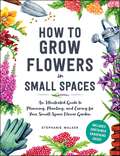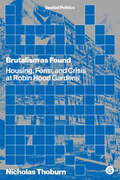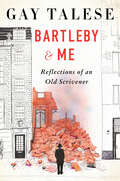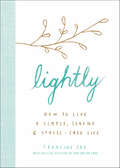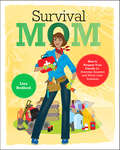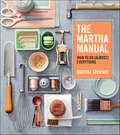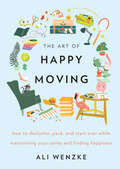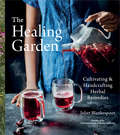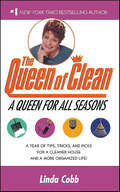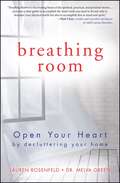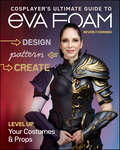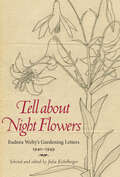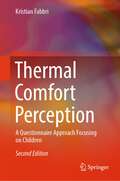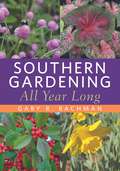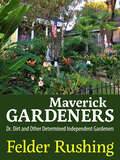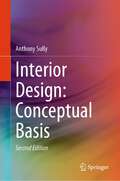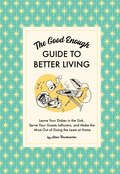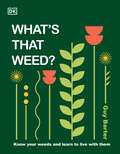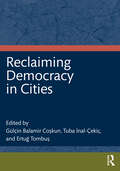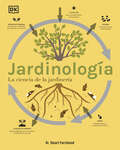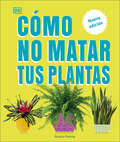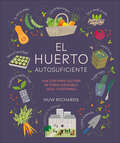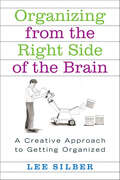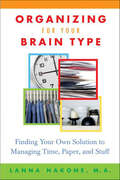- Table View
- List View
How to Grow Flowers in Small Spaces: An Illustrated Guide to Planning, Planting, and Caring for Your Small Space Flower Garden
by Stephanie WalkerTake your gardening to the next level…with flowers! After learning how to manage their houseplants and grow their own food, this highly stylized, fully illustrated, modern guidebook teaches reluctant green thumbs to brighten up their gardens with flowers.Did you know that begonias can be dug up in the fall, stored indoors in the winter, and be ready to be planted and bloom again in the spring? That daylilies need to be divided every three to four years to produce more blooms? Or that marigolds can be both a beautiful and helpful addition to a vegetable garden as a natural deterrent to common garden pests? Whether you&’re a first-time gardener or an experienced green thumb looking to learn more about flowers, this book is your must-have guide! How to Grow Flowers in Small Spaces features 40 beautiful flowers (from smaller pincushion flowers to towering lilacs) that can all be grown in containers or small spaces. Along with detailed care instructions and beautiful illustrations of each plant, you&’ll also find everything you need to know for your floral garden to flourish, including: -How to establish a garden bed (no matter the size!) -How to determine which flowers are best grown from seeds or from transplants -How to water your flowers for optimal growth (whether they&’re in the ground or in a container) -How to turn those blooms into a beautiful home-grown bouquet -And much more! No more trips to the florist—with How to Grow Flowers in Small Spaces, your home and garden will be bursting with color to keep you healthier and happier than ever. From peonies and marigolds to snapdragons and foxgloves, grab your gloves and get to gardening!
Brutalism as Found: Housing, Form, and Crisis at Robin Hood Gardens (Spatial Politics)
by Nicholas ThoburnA critical appropriation of Brutalism in the crisis conditions of today.The Robin Hood Gardens public-housing estate in East London, completed in 1972, was designed by Alison and Peter Smithson as an ethical and aesthetic encounter with the flux and crises of the social world. Now demolished by the forces of speculative development, this Brutalist estate has been the subject of much dispute. But the clichéd terms of debate—a &“concrete monstrosity&” or a &“modernist masterpiece&”—have marginalized the estate&’s residents and obscured its architectural originality. Recovering the social in the architectural, this book centers the estate&’s lived experience of a multiracial working class, not to displace the architecture&’s sensory qualities of matter and form, but to radicalize them for our present.Immersed in the materials, atmospheres, social forms and afterlives of this experimental estate, Robin Hood Gardens is reconstructed here as a socio-architectural expression of our times out of joint.
Gifts from Georgia's Garden: How Georgia O'Keeffe Nourished Her Art
by Lisa RobinsonCome behind the scenes of Georgia O&’Keeffe&’s famous flower paintings to her sustainable homestead in New Mexico, where art was everything and everything was art.Most of us have heard the name Georgia O&’Keeffe— she&’s one of the most famous women in art history. But did you know that for most of her life, she lived on her own land in New Mexico, grew her own food, bought locally, and even made her own clothing?Georgia&’s garden and her art fed and enriched one another, just as her bean plants enriched the soil and her home-grown feasts fed her friends. In spite of the era&’s prejudice against female artists, Georgia lived and thrived in her verdant sanctuary well into old age. Soothing and inspiring, Gifts from Georgia&’s Garden illuminates the life and philosophy of a figure every child should know. Backmatter adds context to O&’Keeffe&’s story and invites families to try out her sustainable gardening techniques— and her pecan butterball cookies.Gifts for Georgia&’s Garden is the latest in Lisa Robinson&’s collection of thoughtful, artfully-told picture book biographies on figures who broke the mold and made history because of it. Hadley Hooper, a painter in her own right and the illustrator of books about Matisse (The Iridescence of Birds) and Giacometti (Two Brothers, Four Hands), perfectly evokes Georgia O&’Keeffe&’s style with pictures that burst with color and life.
Bartleby and Me: Reflections of an Old Scrivener
by Gay Talese“Literary Legend” (New York) Gay Talese retraces his pioneering career, marked by his fascination with the world's hidden characters.In the concluding act of this "incomparable" (Air Mail) capstone book, Talese introduces readers to one final unforgettable story: the strange and riveting all new tale of Dr. Nicholas Bartha, who blew up his Manhattan brownstone—and himself—rather than relinquish his claim to the American dream.“New York is a city of things unnoticed,” a young reporter named Gay Talese wrote sixty years ago. He would spend the rest of his legendary career defying that statement by celebrating the people most reporters overlooked, understanding that it was through these minor characters that the epic story of New York and America unfolded. Inspired by Herman Melville’s great short story “Bartleby, the Scrivener,” Talese now revisits the unforgettable “nobodies” he has profiled in his celebrated career—from the New York Times’s anonymous obituary writer to Frank Sinatra’s entourage. In the book’s final act, a remarkable piece of original reporting titled “Dr. Bartha’s Brownstone,” Talese presents a new “Bartleby,” an unknown doctor who made his mark on the city one summer day in 2006. Rising within the city of New York are about one million buildings. These include skyscrapers, apartment buildings, bodegas, schools, churches, and homeless shelters. Also spread through the city are more than 19,000 vacant lots, one of which suddenly appeared some years ago—at 34 East 62nd Street, between Madison and Park Avenues—when the unhappy owner of a brownstone at that address blew it up (with himself in it) rather than sell his cherished nineteenth-century high-stoop Neo-Grecian residence in order to pay the court-ordered sum of $4 million to the woman who had divorced him three years earlier. This man was a physician of sixty-six named Nicholas Bartha. On the morning of July 10, 2006, Dr. Bartha filled his building with gas that he had diverted from a pipe in the basement, and then he set off an explosion that reduced the fivestory premises into a fiery heap that would injure ten firefighters and five passersby and damage the interiors of thirteen apartments that stood to the west of the crumbled brownstone.Talese has been obsessed with Dr. Bartha’s story and spent the last seventeen years examining this single 20 x 100 foot New York City building lot, its serpentine past, and the unexpected triumphs and disasters encountered by its residents and owners—an unlikely cast featuring society wannabes, striving immigrants, Gilded Age powerbrokers, Russian financiers, and even a turncoat during the War of Independence—just as he has been obsessed with similar “nobodies” throughout his career. Concise, elegant, tragic, and whimsical, Bartleby and Me is the valedictory work of a master journalist.
Lightly: How to Live a Simple, Serene & Stress-free Life
by Francine JayLife is weighing us down. Each day we add more possessions, more commitments, more worries, more stress to our lives. Striving for fulfillment, our closets become overstuffed, our calendars overscheduled, and our spirits overwhelmed. Instead of feeling happy, we just feel heavy.Lightly offers help. Whether you want to strip down your life to a backpack or free up some space in your closet, overhaul your schedule or gain back an hour in the evening, Lightly helps you identify what you treasure, while letting what&’s unnecessary fall away. You will learn to lighten: Your Stuff: advice on how to declutter what&’s weighing you downYour Spirit: release the worries and emotional baggage that can be just as burdensome as possessionsYour Stress: reclaim your time and strive not to get more done, but to have less to doYour Step: reduce your consumption and make the planet as beautiful and clutter-free as your homeWithout a strict regimen, Lightly puts the power back in your hands to take control of your life.
Survival Mom: How to Prepare Your Family for Everyday Disasters and Worst-Case Scenarios
by Lisa BedfordFrom the creator of TheSurvivalMom.com comes this first-of-its-kind guidebook for all the “prepper” moms keen to increase their family's level of preparedness for emergencies and crises of all shapes and sizes. Publisher’s Weekly calls Lisa Bedford’s Survival Mom an “impressively comprehensive manual,” saying, “suburban mom Bedford helps readers learn about, prepare for, and respond to all manner of disasters. . . . From 'Instant Survival Tip' sidebars to a list of 'Lessons from the Great Depression'. . . Bedford's matter-of-fact yet supportive tone will keep the willies at bay.”
The Martha Manual: How to Do (Almost) Everything
by Martha StewartEssential life skills from America's most trusted lifestyle expert—together in one beautiful and practical handbook, with hundreds of ideas, instructions, and inspirations Martha Stewart is America&’s go-to source for the best answers to nearly every question. As an authority on the many worlds upon which she&’s built her domestic empire, she can advise on everything from creating a cutting garden and setting the table to playing classic lawn games or building a campfire. Whether it&’s organizing, celebrating, cleaning, decorating, or any number of other life skills, these are the time-tested, Martha-approved strategies for frequent challenges and basic how-to knowledge that everyone should have at the ready. Also included are plenty of solutions for the not-so-common conundrums, such as how to transport a decorated cake, bathe a cat, or fold an American flag. With hundreds of expert tips and useful insights in an easy-to-follow format, this is the manual you need to learn how to do everything—the Martha way.
The Art of Happy Moving: How to Declutter, Pack, and Start Over While Maintaining Your Sanity and Finding Happiness
by Ali WenzkeA comprehensive, upbeat guide to help you survive the moving process from start to finish, filled with fresh strategies and checklists for timing and supplies, choosing which items to toss and which to keep, determining the best place to live, saying farewell and looking forward to hello.Moving is a major life change—time consuming, expensive, often overwhelming, and sometimes scary. But it doesn’t have to be! Instead of looking at it as a burdensome chore, consider it a new adventure.Ali Wenzke and her husband moved ten times in eleven years, living in seven states across the U.S. She created her popular blog, The Art of Happy Moving, to help others build a happier life before, during, and after a move. Infused with her infectious optimistic spirit, The Art of Happy Moving builds on her blog, offering step-by-step guidance, much-needed comfort, practical information, and welcome advice on every step of the process, including: How to stage your home for prospective buyersHow to choose your next neighborhoodHow to discard your belongings and organize your packingHow to say goodbye to your friendsHow to make the transition easier for your kidsHow to decorate your new homeHow to build a new communityAnd so much more.Ali shares invaluable personal anecdotes from her many moves, and packs each chapter with a wealth of information and ingenious tips (Did you know that if you have an extra-large welcome mat at the entrance of your home, it’s more likely to sell?). Ali also includes checklists for packing and staging, and agendas for the big moving day.Whether you’re a relocating professional, newly married, a family with kids and pets, or a retiree looking to downsize, The Art of Happy Moving will help you discover ways to help make your transition an easier one—and be even happier than you were before.
The Healing Garden: Cultivating and Handcrafting Herbal Remedies
by Juliet BlankespoorA comprehensive and lushly photographed guide to growing and using healing plants, including recipes, from the founder of the Chestnut School of Herbal MedicineThis is the ultimate reference for anyone looking to bring the beauty and therapeutic properties of plants into their garden, kitchen, and home apothecary. Both informative and accessible, it covers how to plan your garden (including container gardening for small spaces); essential information on seed propagation, soil quality, and holistic gardening practices; 30 detailed profiles of must-know plants (including growing information, medicinal properties, and how to use them); foundational principles of herbalism; step-by-step photographic tutorials for preparing botanical medicine and healing foods; and 70 recipes for teas, tinctures, oils, salves, syrups, and more. Packed with sumptuous photography, this book will appeal to home gardeners who want to branch out to culinary and medicinal herbs, home cooks and those interested in natural wellness, and novice and skillful herbalists alike.
A Queen for All Seasons: A Year of Tips, Tricks, and Picks for a Cleaner House and a More Organized Life!
by Linda CobbThe Queen of Clean with her royal tips for every season, an untidy home would almost be treason! Winter Make snow shoveling a breeze...store holiday decorations with no tangles...humidify dry indoor air...care for flannel sheets...make those Valentine's gems sparkle Spring Garden the natural way...allergy-proof your home...banish grass stains...color your Easter eggs Summer Prepare for family road trips...care for your camping equipment...keep bugs away without chemicals...clean your sports gear Fall Get organized for back to school...store your summer clothes properly...put away your air conditioner...prepare for stress-free holidays!
Breathing Room: Open Your Heart by Decluttering Your Home
by Melva Green Lauren RosenfeldCleaning out your cupboards isn’t just about a tidier kitchen. Find peace, repair your past, and live a more fulfilled life with this uplifting guide to the spiritual practice of decluttering.Bless your clutter. Yes, you heard right: Bless it. Bless everything in your life that is superfluous, broken, burdensome, and overwhelming—because it is all here to teach you an important lesson, perhaps the most important lesson there is: what really matters. Everyone’s lives could use some serious decluttering. But decluttering isn’t just about sorting junk into piles and tossing things in the trash. Decluttering can inform us of our burdens, help us to understand our attachments, and aid us in identifying what is truly valuable in our lives. Written by a medical doctor and a spiritual intuitive, with case studies of people just like you, Breathing Room takes you on an enlightening room-by-room tour where each room in your home corresponds to a “room” in your heart, and where decluttering will not just make space but improve the spirit. So, if it’s weighing you down, if it’s become an obstacle, if it’s making it near impossible for you to find the things you really love—it’s time for you to let it go and find a little breathing room.
Cosplayer's Ultimate Guide to EVA Foam: Level Up Your Costumes & Props
by Beverly DownenUnlock the unlimited possibilities of EVA foam! Turn your wildest costume dreams into reality! Whether you are a master-level cosplayer or brand-new to making costumes and props, this is the ultimate reference guide to using different kinds of EVA foam and other up-to-date materials and to make epic costumes, props, accessories, and other projects out of this world! If you want to create your own high quality props, EVA foam is the way to go — it is a rubber-like thermoplastic that is both easy to work with, durable, and lightweight. You can build an entire costume with EVA foam — shields, armor, helmet, weapons — without getting weighed down. Knowledge at your fingertips! This comprehensive guidebook - take it with you to shop for materials, write notes and bookmark your favorite chapters, and use it right at your workstation Expand your cosplay skills with the latest industry techniques and materials, step-by-step tutorials, and 4 projects to get you started Create patterns for perfectly fitting costumes and accessories every time and use the patterns included to guide the way
Tell about Night Flowers: Eudora Welty's Gardening Letters, 1940-1949
by Julia EichelbergerTell about Night Flowers presents previously unpublished letters by Eudora Welty, selected and annotated by scholar Julia Eichelberger. Welty published many of her best-known works in the 1940s: A Curtain of Green, The Wide Net, The Robber Bridegroom, Delta Wedding, and The Golden Apples. During this period, she also wrote hundreds of letters to two friends who shared her love of gardening. One friend, Diarmuid Russell, was her literary agent in New York; the other, John Robinson, was a high school classmate and an aspiring writer who served in the Army in WWII, and long the focus of Welty's affection. Welty's lyrical, witty, and poignant discussions of gardening and nature are delightful in themselves; they are also figurative expressions of Welty's views of her writing and her friendships. Taken together with thirty-five illustrations, they form a poetic narrative of their own, chronicling artistic and psychic developments that were underway before Welty was fully conscious of them. By 1949 her art, like her friendships, had evolved in ways that she would never have predicted in 1940. Tell about Night Flowers not only lets readers glimpse Welty in her garden; it also reveals a brilliant and generous mind responding to the public events, people, art, and natural landscapes Welty encountered at home and on her travels during the 1940s. This book enhances our understanding of the life, landscape, and art of a major American writer.
Thermal Comfort Perception: A Questionnaire Approach Focusing on Children (Springerbriefs In Applied Sciences And Technology Ser.)
by Kristian FabbriThis book offers a comprehensive exploration of children's understanding and experiences of thermal comfort. The book provides a methodology for evaluating comfort that takes into account the unique perspectives of children. The first part of the book provides an overview of the history of thermal comfort, the human body and environmental parameters, and common thermal comfort indexes. It also offers guidelines for creating questionnaires that accurately assess children's perceptions of indoor thermal comfort. The book then delves into children's understanding of the concepts of comfort and energy, as well as the factors that influence their perception of these concepts. It addresses the psychological and pedagogical aspects of thermal comfort judgment, as well as the architectural and environmental characteristics that contribute to children's perceptions of comfort. First published as Indoor Thermal Comfort Perception, this updated edition also includes new sections on architecture and sensitivity, exploring the impact of classroom spaces on learning, and outdoor education and thermal comfort outdoors, based on qualitative research. These additions provide valuable insights for future studies on these topics. While physical parameter measurements and comfort indexes are useful in thermal comfort, the book emphasizes the importance of ergonomic assessments in the form of questionnaires, which offer unique insights into children's experiences. The book fills a critical gap in understanding children's perceptions of thermal comfort and is essential reading for HVAC engineers, architects, environmental psychologists, and researchers in the medical and cognitive fields.
Southern Gardening All Year Long
by Gary R. BachmanSouthern Gardening All Year Long approaches southern landscapes from a different perspective. Instead of encyclopedic lists and articles focused on botanical gardens or someone else’s landscape, author and host of Southern Gardening Gary R. Bachman connects with his audience through personal stories that share his expertise gained over decades of planting, all told in an easily digestible format. Most stories in Southern Gardening All Year Long focus on Bachman’s hands-on experience with gardening. He recounts tales about his own personal gardens—plants that have thrived and failed—and presents his advice in a common-sense style. Bachman's personal, conversational writing makes Southern Gardening All Year Long an old-fashioned, over-the-fence chat with a knowledgeable and helpful neighbor. Just as he has done in newspapers, and on television and radio, with Southern Gardening All Year Long, Bachman hopes to help gardeners be successful in their own landscapes, alleviate some of the apprehension new gardeners feel, and inspire experienced gardeners to try new plants instead of the same old plantings every year. Gardening success doesn’t always follow steps 1-2-3, but Bachman encourages readers not to worry about plants that don’t survive. Failures happen in gardens every season. Offering a variety of tips and tricks and over 170 color images, Southern Gardening All Year Long will become a gardener’s best friend.
Maverick Gardeners: Dr. Dirt and Other Determined Independent Gardeners
by Felder Rushing“Be forewarned that this book honors people like the woman in my hometown who paints the numbers of her favorite NASCAR drivers on her elephant ears, and a Tokyo gardener with over a hundred bonsai plants.” So says renowned garden journalist Felder Rushing in his new book Maverick Gardeners: Dr. Dirt and Other Determined Independent Gardeners. In this book, Felder delves deeply into the psychology of what motivates and sustains the Keepers of the Garden Flame. For thousands of years, a loosely connected web of unique, nontraditional gardeners has bonded people across race, culture, language, and other social conventions through sharing unique plants and stories. Found in nearly every neighborhood worldwide, these “determined independent gardeners” (DIGrs) are typically nonjoiners who garden simply and exuberantly, eschewing customary horticultural standards in their amateur pursuits of personal bliss. Included in Maverick Gardeners are classic “passalong plant” lists, a dollop of how-to, numerous color photographs, and thought-provoking essays on quintessential tools, sharing with others, getting away with wildflowers in suburbia, and organizing a plant swap. The centerpiece of this unique gardening journey is the no-holds-barred story of a ten-year cross-cultural collaboration between the horticulturist author and a flamboyant rebellious gardener who called himself Dirt. Through swapping plants and garden lore—and rubbing shoulders with fellow DIGrs—they unraveled their shared humanity. From the practical to the inspiring, Maverick Gardeners is the perfect book for those nonconformist souls who see no sense in trying to fit in and follow the footpaths of others.
Interior Design: Conceptual Basis
by Anthony SullyThis book introduces interior design as a conceptual way of thinking, which is about ideas and how they are formulated. Now in its second edition, the book is enlarged to include topical subjects such as artificial intelligence, sustainability and climate change. The book prepares designers to focus on each concept independently as much as possible, whilst acknowledging relative connections without unwarranted influences unfairly dictating a conceptual bias, and is about that part of the design process called conceptual analysis. The major themes of this second edition of Interior Design: Conceptual Basis are the seven concepts of planning, circulation, 3D, construction, materials, colour and lighting, which cover the entire spectrum of a designer’s activity. It is assumed that the site, location, building and orientation as well as the client’s brief of activities and needs have been digested and analysed to provide the data upon which the design process can begin. Designed as a highly visual illustrative book, as the interior design medium demands, the hands-on creative process of designing is detailed with original drawn illustrations. Concentrating on the conceptual process of designing interiors, and defining what these concepts are, this book helps the designer to organise his/her process of designing and to sharpen the links between the various skill bases necessary to do the job. This book is stimulating for students and instructors alike and is aimed at any student who maybe majoring in interior design, interior architecture, architecture, design thinking or furniture design. It is also useful reference for students of design management and design leadership.
The Good Enough Guide to Better Living: Leave Your Dishes in the Sink, Serve Your Guests Leftovers, and Make the Most Out of Doing the Least at Home
by Alison ThrockmortonWith an abundance of hilarious household tips, Leave Your Dishes in the Sink is here to teach you how to look like you're doing the most by doing less.Most home economics books share the same guidance: "the best way of doing things." In a world of Instagram-worthy homes and Pinterest-perfect meals, sometimes the best way of doing things feels unattainable. Leave Your Dishes in the Sink teaches you how to work with life’s most relatable habits to create the illusion of upkeep and a façade of cleanliness. Taking you room by room—from the kitchen and the living room to the bedroom and the bathroom—you’ll learn the proper (aka easiest) way of doing things. Avoid dirty dishes by eating out of the jar. Choose the houseplant that will match your level of self-doubt. And who needs folding the laundry when you have The Chair? You’ll even find out how to entertain your guests without them noticing you haven’t vacuumed your carpet since you signed your lease.With the help of elegant charts and diagrams, you’ll find answers to some of the life’s toughest questions, including:How do I fold a fancy napkin? (Just don’t.)Does a bucket count as a cup? (Yes.)Which way does the toilet paper roll go? (Who cares!)Witty and absurd, Leave Your Dishes in the Sink is a hilarious reminder that real life exists and it’s okay to give yourself a break. By doing less, you too can create your dream home—or at least one that’s totally fine just the way it is.The best kind of self-improvement book, this anti-perfectionism guide gives you permission to give yourself a break while getting in some laughs!LAUGH-OUT-LOUD RELATABLE: Author Alison Throckmorton perfectly distills all the universal shortcuts we take as adults trying to keep it all together, like leaving your dishes in the sink "to soak" and using that one chair you have as a second dresser.REAL-WORLD HOUSEHOLD HINTS & TIPS: For anyone exhausted by searching for things that spark joy or the TikToks pushing housecleaning as therapy, this guide offers the perfect mix of parody and empathy. Step over the laundry pile to flip through these delightfully illustrated pages for tips and tricks to finding happiness among the chaos.FUNNY GIFT FOR EVERYBODY: This book makes a great gift for a recent graduate, a friend who just became a homeowner or renter, a new mom, or a parent who has been keeping the house together for thirty years.Perfect for:Anyone who hates doing household chores (everyone)Millennials trying to adultNew renters or homeownersGift-giving for birthday, graduation, Mother’s Day, or Father's DayReaders of Feathered & Fabulous, The Underachiever's Manifesto, and The Subtle Art of Not Giving a F*ck
What's That Weed?: Know Your Weeds and Learn to Live with Them
by DKLearn all about common weeds and how they affect your garden to make informed decisions about the plants you want in your patch - and how to manage those that you don't.Figuring out which weed is which can be tricky for new and seasoned gardeners alike. In this book, garden expert Guy Barter lifts the lid on how weeds grow and in what conditions. Discover each weed's benefit to wildlife, biodiversity, and its role in the environment - plus whether it has ornamental, herbal, or edible properties that you might want to make the most of.This identification guide covers 40 weeds commonly found in gardens in Europe and North America. Alongside well-known weeds such as nettles, dock, dandelions, and bindweed, you'll find hawksbeard, pearlwort, ivy-leaved speedwell, and pennycress.In this book, you will find: -Detailed photographs and diagrams of each element of the plant, from roots to leaves-Specific tools to help you recognize weeds throughout their entire life cycles, from starting out as seedlings before growing into mature flowers.-The best way to manage each weed and curate the perfect plants for your patch.-Each weed's place within the ecosystem is listed, along with benefits, such as use as an ornamental, herbal, or edible plant-Every element of the 40 weeds along each stage of their life cycle, enabling clear identification for gardeners.With this guide, you can identify plants and understand more about weeds and roots and their benefits.The perfect title for seasoned gardeners who are looking to identify, manage, and control the weeds in their gardens or new gardeners who are keen to learn about and identify the existing plants in their gardens.
Reclaiming Democracy in Cities
by Gülçin Balamir Coşkun Tuba İnal-Çekiç Ertuğ TombuşEffective urban governance is essential in responding to the challenges of inequality, migration, public health, housing, security, and climate change. Reclaiming Democracy in Cities frames the city as a political actor in its own right, exploring the city’s potential to develop deliberative and participatory practices which help inform innovative democratic solutions to modern day challenges.Bringing together expertise from an international selection of scholars from various fields, this book begins with three chapters which discuss the theoretical idea of the democratic city and the real-world applicability of such a model. Part II discusses new and innovative democratic practices at the local level and asks in what way these practices help us to rethink democratic politics, institutions, and mechanisms in order to move toward a more egalitarian, pluralist, and inclusive direction. Drawing on the Istanbul municipal elections and the Kurdish municipal experience, Part III focuses on the question of whether cities and local governments can lead to the emergence of strong democratic forces that oppose authoritarian regimes. Finally, Part IV discusses urban solidarity networks and collaborations at both the local level and beyond the nation, questioning whether urban solidarity networks and alliances with civil society or transnational city networks can create alternative ways of thinking about the city as a locus of democracy.This edited volume will appeal to academics, researchers, and advanced students in the fields of urban studies, particularly those with an interest in democratic theory; local democracy; participation and municipalities. It will also be relevant for practitioners of local governments, NGOs, and advocacy groups and activists working for solidarity networks between cities.
Jardinología (The Science of Gardening): La ciencia de la jardinería
by Dr. Stuart FarrimondUn libro de jardinería diferente que explica la ciencia detrás de la jardinería de forma visual y clara.¿El mundo de la botánica y la jardinería te parecen un misterio? Las guías de jardinería al uso tienden a dar gran cantidad de instrucciones y consejos, pero rara vez aportan explicaciones sobre el por qué. ¡No te preocupes! El Dr. Stuart Farromond arroja luz sobre todas esas preguntas que siempre te has hecho y te explica lo que sucede en tu jardín desde un enfoque científico.La guía botánica definitiva para entender los secretos de la horticultura y la floricultura como un profesional:Escrita con un lenguaje accesible y libre de tecnicismos en formato pregunta y respuesta. Con explicaciones claras, apoyadas por gráficos y esquemas para ilustrar los conceptos de forma visual.Estructurado en torno al ciclo de vida de un jardín, desde los primeros brotes hasta el momento de la poda.Explica los beneficios de la jardinería para la salud mental y el medio ambiente.Un práctico manual de jardinería con explicaciones y consejos avalados por la ciencia, que te ayudará a comprender mejor cómo se comportan las plantas, desmitificar creencias y descubrir las bases y avances de la horticultura moderna. ------------------------The only book to explain the science behind gardening practice in a simple and visually accessible way.The world of gardening can be a mystifying place, with so many instructions to follow and often little explanation as to why. Dr. Stuart Farromond casts his scientific eye over a typical year in the garden to answer all the horticultural questions you&’ve ever wanted the answer to. This great gardening book provides a shortcut to decades of gardening experience by explaining the science behind how a garden grows, featuring: An accessible guide structured around the life cycle of the garden, taking you from first shoots to pruning for renewal. An accessible Q &A format, with stats and infographics to bring the story to life, as well as long-held gardening myths are exploded by new science. Every way to greener fingers has an action point so that you can understand the science, apply your gardening practice, and enjoy a flourishing garden.From hands-on, practical advice, to an exploration of the mental health benefits of gardening, while also covering topics such as the positive impact gardening can have on the earth during a time of climate crisis in between, The Science of Gardening debunks myths and reveals the latest science only taught at horticultural college. As a passionate newcomer to gardening, daunted by the mountain of often conflicting advice in gardening manuals, Dr. Stu has set about testing the scientific basis of so much conventional wisdom and practice so you too can garden like a pro.
Cómo no matar tus plantas (How Not to Kill Your Houseplant): Nueva edición
by Veronica PeerlessPor mucho que riegues tus plantas siguen estando débiles: hojas que se caen, amarillean y tienen manchas. ¿Qué ocurre? Esta guía de plantas de interior te explica de manera fácil los problemas que pueden estar sufriendo.Detecta las señales de peligro, aprende cómo puedes rescatarlas y descubre qué planta se adapta mejor a tus necesidades. Puedes colocarlas en espacios muy diferentes: baños, cuartos fríos, encima del escritorio, en el marco de una ventana, en un rincón sombrío o en un solárium caliente. ¡Crea tu propio oasis dónde tú quieras!Este libro de plantas también incluye: Consejos para comprender qué les gusta y qué no.Indicaciones sobre cuánta luz, agua, calor y humedad necesitan.Explicaciones para principiantes de las diferentes etapas de crecimiento de la planta.¡Pasa las páginas y descubre cómo salvar a tus plantas! Identifica qué hay plantado en tu maceta y asegúrate de que crezca sana y fuerte. El regalo perfecto para todo aquel que busca poner una planta en su vida y para amantes de las plantas con poca experiencia que quieren adquirir nuevos conocimientos. -------------------------------Learn all the tips and tricks you need to become a proud plant parent – of more than 100 different plants.Yellowed leaves, drooping leaves, dried leaves, even though you've watered it: what&’s going on? How Not to Kill Your Houseplant will explain – and fix – your houseplant woes. Learn to spot the danger signs and take the proper action to rescue your sick plant. Discover the perfect plant for your unique space and needs. Bathrooms, cold rooms, at a desk, on a windowsill, in a gloomy corner or hot suntrap: there are plants for every location to create your own indoor oasis.This perfect plant book further features: Quick tips to understand what your plant does and doesn't like: How much light, water, food, heat, and humidity. Every stage of plant parenting for beginners, from identifying exactly what's in the pot, to keeping it in check when it grows too well. Proving the idea self-purchase or gift purchase for complete beginners who have no experience with or knowledge of plants, as well as [people who want to increase the amount of greenery in their life with indoor plants.
El huerto autosuficiente (Grow Food for Free)
by Huw Richards¿Te gustaría cultivar tus propias verduras, frutas y hortalizas con coste cero?Huw Richards logró autoabastecerse de la comida de su propio huerto durante todo un año y ¡tú también puedes! Pasa las páginas de este completo manual de horticultura y aprende todo lo que necesitas saber para cultivar y recolectar tus propios alimentos de manera autosuficiente y ecológica.Sea cual sea el espacio con el que cuentes o la experiencia que tengas, este guía de cultivo te enseña cómo hacer un huerto en casa de forma fácil:Consejos para elegir el lugar y el sistema de cultivo más adecuados: el jardín, el balcón, una azotea o terraza, en el suelo, en camas elevadas, en contenedores…Información sobre las herramientas de jardinería y los materiales que necesitas.Cómo preparar y sembrar la tierra, hacer compost, eliminar malezas, plagas y enfermedades, conseguir semillas.Fichas de cultivo de más de 30 tipos de plantas, populares y perennes.Incluye un diario de cultivo de 54 semanas donde Huw Richards explica cómo cultivó sus propios alimentos durante todo un año sin gastar nada de dinero.Consejos sobre cómo vender tu cosecha y conseguir dinero para agrandar la zona de cultivo.El libro de jardinería perfecto para todo aquel que desee iniciarse en el arte del huerto urbano y cultivar sus propios alimentos orgánicos y saludables.--------------------------------------------Zero-cost, low effort and a long term solution to your fresh produce needs!Huw Richards set himself a challenge - to be self-sufficient by growing his own fruit and veg for free for a year. He succeeded, and now wants to help you do the same.Grow your own food in your home garden, allotment or container and look forward to a bountiful harvest year-round. You can plant fruit and veg at home without spending a penny and Huw Richard's shows you how.Packed with tried-and-tested advice, this gardening book covers:Finding a space to grow - in the garden or on a terrace or balcony - and sourcing the materials you needDeciding what to grow your crops in (the ground, a raised bed, or containers)Clear growing instructions on more than 30 species of popular annual and perennial cropsHuw Richards' 52-week journal of how he grew his own food for free for a year without spending a pennyAdvice on how to go about selling your produce to raise money to expand your growing areaLearn about the space you need and how to prepare it, make your own compost, tackle weeds, pests, and diseases, and how to get hold of your first set of seeds! Discover many strategies to expand your garden for the better.
Organizing from the Right Side of the Brain: A Creative Approach to Getting Organized
by Lee SilberAlmost all the organizing books on the market today target the "left-brainer" - people who are generally disciplined, neat, and analytical. But for those who are more creative and spontaneous rather than logical and detail-oriented, help is on the way! In this book, Lee Silber turns traditional organizing advice on its head and offers unique solutions that complement the unorthodox lifestyle of the creative "right-brainer."For example:* Discover how right-brainers can be organized in a left-brain world* Overcome obstacles that stand in the way of being more organized* Pile, don't file - put paper in its place the right-brained way* Learn how being a "pack rat" can be a good thingThis creative new approach to getting it together is perfect for those who can't relate to boring traditional organizing techniques!
Organizing for Your Brain Type: Finding Your Own Solution to Managing Time, Paper, and Stuff
by Lanna NakoneAn astute, accessible, and fun guide that explains once and for all why all those organizing books only help 25% of usLet your natural inclinations guide you toward gaining control of your environment and learn to live life on your own terms. Drawing on the science of brain function and her experience as a professional organizer, Lanna Nakone offers tailored and specific advice that will actually work to help you tame your desk, unclutter your closet, manage your time, and save your sanity.Take the Brain Style quiz to determine which of the four parts of the brain you rely on the most to process information, and which organizing style complements your brain function. If you rely on the* Posterior left section of your brain, you're a Maintaining Style. You develop and follow routines well and adhere to traditional organizing methods. * Frontal right section of your brain, you're an Innovating Style. Artistically creative, you have a unique stacking system that no one else understands. * Posterior right section of your brain, you're a Harmonizing Style. Valuing interconnectedness with your family or coworkers, you need to be organized enough to keep your environment peaceful. * Frontal left section of your brain, you're a Prioritizing Style. Adept at analyzing data, you prefer to delegate organizing. Chapters specific to each type offer practical tips and strategies for implementing an organizing system, maintaining your system, and coexisting with different brain styles.Insightful and understanding, Organizing for Your Brain Type turns the task of managing your life into an enjoyable experience.
